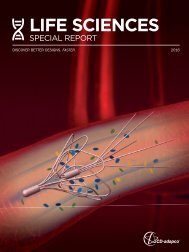Life Science Special Report December 2015
The Life Sciences Sector is experiencing an unprecedented change...
The Life Sciences Sector is experiencing an unprecedented change...
- No tags were found...
Create successful ePaper yourself
Turn your PDF publications into a flip-book with our unique Google optimized e-Paper software.
HIGH-TECH OPERATING ROOM LIFE SCIENCES<br />
CFD ANALYSIS OF A<br />
HIGH-TECH OPERATING<br />
ROOM USING STAR-CCM+ ®<br />
CLEMENS BULITTA, FRANZ MAGERL, REINHOLD HARTWICH &<br />
BENJAMIN RUSSWURM<br />
Technical University of Applied <strong>Science</strong>s Amberg-Weiden<br />
INTRODUCTION<br />
A fully functioning high-tech Operating<br />
Room (OR) with a sophisticated ventilation<br />
system was built recently at the Technical<br />
University of Applied <strong>Science</strong>s Amberg-<br />
Weiden in Germany, for teaching and<br />
research purposes. The high-tech OR<br />
enhances the university’s Medical<br />
Engineering programs and acts as an<br />
innovation center for the regional health<br />
industry. The OR permits the exploration<br />
of a number of health-related R&D issues,<br />
including:<br />
• Use and application of intraoperative<br />
imaging<br />
• Technology integration<br />
• Medical engineering planning<br />
• Ergonomic concerns and use suitability<br />
• Workflow and efficiency<br />
• Hygiene and air conditioning / airflow<br />
technologies<br />
With the recent surge in nosocomial<br />
infections (i.e. infections contracted in<br />
clinics or hospitals), finding new ways<br />
to effectively thwart contamination<br />
and ensure patient safety has become<br />
imperative [1].<br />
Hygiene in medical environments,<br />
especially in the operating and procedure<br />
rooms, is of vital importance. In an<br />
implantation, joint or bone surgery for<br />
example, where large areas are exposed<br />
and must remain aseptic, there is a very<br />
high risk of nosocomial infection, and as<br />
such, maintaining a hygienic environment<br />
is a fundamental requirement. In order to<br />
eliminate the risk of contamination<br />
of the patient, OR staff or medical<br />
instruments, it is critical that the<br />
ingress of foreign particles or agents<br />
be reduced to a minimum.<br />
In addition to inadequate hygiene,<br />
another risk factor concerns the<br />
disruption of airflow in an OR. Laminar<br />
AirFlows (LAF) are generated by special<br />
air conditioning systems in order to<br />
ensure a protective, germ-free air climate<br />
around the operating table. However,<br />
imaging procedures, OR monitors, or<br />
even ineffective OR lighting can adversely<br />
impact the protective effect of the<br />
laminar airflow. [2]<br />
VENTILATION SYSTEM IN THE<br />
OPERATING ROOM<br />
In accordance with the German hospital<br />
room Class 1 standard DIN 1946-4<br />
("Ventilation in Healthcare Buildings and<br />
Rooms"), the OR must have a Room<br />
Ventilation System (RVS) to regulate<br />
the inflow, filter the air and control<br />
the temperature and humidity in the<br />
room. The air goes through a grade H13<br />
(absolute) High-Efficiency Particulate Air<br />
(HEPA) filter before being fed back into<br />
the OR. The filter, which is located in the<br />
ceiling panels directly over the operating<br />
and instrument tables, supplies a vertical<br />
LAF around the operating area in order to<br />
create a protective zone where exposure<br />
to germs is limited.<br />
However, the laminar nature of the<br />
SPECIAL REPORT<br />
43



